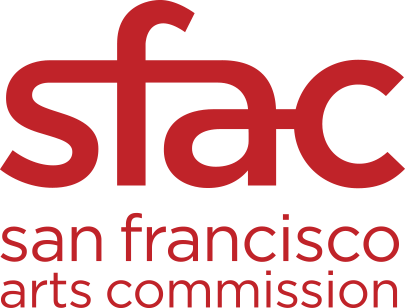Shaping Legacy is a multi-year commitment to critically examine the monuments and memorials in San Francisco’s Civic Art collection.
We believe artists and their communities can guide us towards a future where monuments and memorials are spaces of inclusion, belonging and recognition of our shared humanity.

This project is an opportunity for our agency to holistically assess the Civic Art Collection, build awareness around the collection and processes, rectify current power imbalances, and engage community in a sustained, relevant way.
SFAC will engage communities that have historically been excluded from discussions, produce an Audit report, create opportunities for artist-led activations in public space and support temporary installations that reimagine future monuments and memorials in our city.
Shaping Legacy Audit Report
How to get involved and participate in Shaping Legacy
Sign up for Shaping Legacy updates to stay informed of project updates and opportunities to participate in Shaping Legacy. We’ll be posting upcoming events on this page.
For questions, email: monumentsandmemorials@sfgov.org or leave a voicemail by calling: 415-252-2214.
Monuments & Memorials and Shaping Legacy Project Timeline
Events
Upcoming Events:
- November 6, 2025: Crochet Jam at Compton’s: Thursday, November 6, 6-8pm @ 835 Larkin Street, with Tenderloin Museum and artist Ramekon O’Arwisters
- November 8, 2025: Legacy Youth Day 12-5pm @ La Ofrenda, 2070 Mission Street, with Gray Area and artist Lucia Gonzalez Ippolito
- Civic Center Plaza Temporary Sculpture Installation: Request for Proposals (RFP) - deadline for applications January 12, 2026, 11:59 PM PST
Available Online:
- Legacy as Living Practice: A conversation with artists rethinking legacy and public memory in San Francisco. Featuring Artists Tricia Rainwater, Sophia Tupuola, and Ambrose Trataris followed by a moderated discussion. In partnership with San Francisco Public Library.
- Home Without Borders: A collaborative community art project that encourages intersectional resistance through celebrating immigrants, refugees and asylum seekers. With Macrowaves and Gray Area.
- Lotta's Fountain History Program: Celebrating the 150th anniversary of city and national landmark, Lotta's Fountain with SF Heritage.
Past Events:
- September 21, 2025: LEGACY SHOW presentation and celebration, with YouthSpeaks and artists at Brava Theatre
- September 20, 2025: It's Giving Hella Pasifika Art Exhibition, with the Teu Le Vā San Francisco Artist Circle and Samoan Community Development Center (SCDC) at The Hub
- September 16, 2025: Legacy as Living Practice: A conversation with artists rethinking legacy and public memory in San Francisco. Featuring presentations from Artists Tricia Rainwater, Sophia Tupuola, and Ambrose Trataris followed by a moderated discussion. In partnership with San Francisco Public Library.
- August 23, 2025: Undone & Taken Into Earth: Fort Point Tour with Anna Lisa Escobedo & Workshop with Weston Teruya at 500 Capp Street
- August 23, 2025: American Indian Cultural District’s Mapping Genocide exhibit kickoff celebration and feedback session at SFMOMA
- August 23, 2025: Closing Reception, Untold Histories/Hidden Truths with Mildred Howard at 500 Capp Street
- August 21, 2025: Black Eyes on Black Art with Ramekon O'Arwisters and Mattie Loyce at Tenderloin Museum
- August 14, 2025: Macro Waves: Home Without Borders, Exhibition Opening, workshop and performance with Macrowaves at Gray Area
- August 10, 2025: Civic Monuments in Transition, Fort Point Tour with Anna Lisa Escobedo & post-tour intimate discussion at 500 Capp Street
- August 3, 2025: Protected: Home Without Borders: Clay + 3D Workshop, with Marcrowaves at Gray Area July 20, 2025: Exploring Untitled Histories/Hidden Truths, Fort Point Tour with Anna Lisa Escobedo & Workshop with Malik Seneferu at 500 Capp Street
- July 12, 2025: Subverting Colonial Machinations, Readings and Dialogue with Jonathan Cordero and Tricia Rainwater, 500 Capp Street
- June 19, 2025: Opening Day, Untold Histories/Hidden Truths with Mildred Howard at 500 Capp Street
- May 15, 2025: Set in Stone: A Self-Monumentalizing Workshop with Ambrose Trataris at Gray Area
- April 19, 2025: Speculations on Capture Film Screening w/ Morehshin Allahyari in Conversation with Usha Iyer presented in partnership with Gray Area
- April 17, 2025: Monumentalizing Community: film screening, discussion, & co-creation with Skywatchers and Preethi Ramaprasad presented in partnership with Tenderloin Museum
- December 9, 2024: a lament with yétúndé olágbajú presented in partnership with 500 Capp Street
- November 21, 2024: Shaping Legacy Community Workshop at Southeast Community Center
- November 20, 2024: Shaping Legacy Community Workshop at San Francisco Public Library
- November 18, 2024: Shaping Legacy Community Workshop at Yerba Buena Center for the Arts
Artist Circle Community Collaborators
Community Engagement & Case Study Collaborators
- American Indian Cultural District
- California Migration Museum
- Shaping San Francisco
- SOMA Pilipinas
- Youth Speaks
Funding
Shaping Legacy is funded by a grant from the Mellon Foundation.
Shaping Legacy, a three-year, grant funded initiative, will assess the current monuments and memorials in the Civic Art Collection, engage underrepresented communities in discussions about the commemorative landscape, and create opportunities for artists to reimagine future monuments and memorials in our city.
The Arts Commission will:
- Work with consultant HR&A Advisors to produce an Audit report on the existing monuments and memorials in the Civic Art Collection;
- Engage communities that have historically been excluded from discussions and decisions regarding the commemorative landscape;
- Create opportunities for artist-led activations in public space and support temporary installations that reimagine future monuments and memorials in our city.
Many of the monuments and memorials in the collection do not reflect the diversity of San Francisco, ignore stories of communities of color, and reinforce inequities in race, gender, and culture. This project is an opportunity for our agency to holistically assess the Civic Art Collection, build awareness around the collection and processes, rectify current power imbalances, and engage community in a sustained, relevant way.
Other reasons include:
- To reckon with the legacy of white supremacy, patriarchy, and colonialism reflected in public spaces, specifically in monuments and memorials that are part of the Civic Art Collection.
- To follow through on the recommendations outlined in the Monuments & Memorial Advisory Committee’s Final Report released in May 2023, to work towards an equitable commemorative landscape that reflects the diversity of San Francisco and promotes stories of communities of color.
- To prioritize meaningful community engagement to holistically assess the Civic Art Collection, build awareness around the civic process, rectify current power imbalances, and engage community in a sustained, relevant way.
- The Mellon Foundation awarded a $3 million grant in June 2023 to SFAC to support SFAC’s monuments and memorials initiative through June 2026; San Francisco was one of nine municipalities nationwide that received a Mellon Foundation grant.
- An analysis of current monuments and memorials in Civic Art Collection to identify inequities in the collection and results in recommendations on monuments and memorials to remove, relocate or contextualize, and community stories and narratives to be included in future commemorative projects. A recent example of this type of work is the National Monument Audit report.
Any decisions regarding removal, relocation or reinterpretation of specific monuments will be made through an open, public, and transparent process following SFAC’s Public Art Policies and Guidelines and presented to the Arts Commission for approval.
- San Francisco Monuments & Memorials Advisory Committee Final Report – May 2023
- SFAC News Release – June 2023
- San Francisco’s ‘Early Days’ Statue Is Gone. Now Comes the Work of Activating Real History, Smithsonian Magazine, October 2018
- Participate in community programs and open calls for artists.
- Stay up to date and informed by signing up for Shaping Legacy emails and newsletter.
1. What has happened to the monuments in Golden Gate Park?
The bronze statues of the Padre Junipero Serra (1906), General Ulysses Simpson Grant (1908), and Francis Scott Key (1887) monuments were toppled and defaced by a group of demonstrators on Friday night, June 19. Their remaining pedestals along with a number of other monuments and public cultural ephemera in the Golden Gate Park Music Concourse were also vandalized. Additional Civic Art Collection works that were defaced include Leonitus (Roman Gladiator) (1881), The Cider Press (1892), Goethe and Schiller (1901), Miguel Cervantes (1916), the Rideout Fountain (1923), and Father William D. McKinnon (1927).
The Sphinx sculpture and the Pool of Enchantment – which are under the jurisdiction of the Fine Arts Museums, San Francisco, were also vandalized.
Based on the types of vandalism, some monuments appeared to be specifically targeted for political reasons while others appeared to have just been casualties based on proximity.
2. Where are they now?
The bronze sculptures are stored safely in an undisclosed, secure fine art storage facility (along with the Christopher Columbus statue that was removed by the City on June 18, 2020 and the Early Days sculpture that was removed from Pioneer Monument in September 2018).
3. When did the San Francisco Arts Commission remove the Christopher Columbus statue at Coit Tower?
The City removed the statue early Thursday, June 18, under direction of the Mayor.
4. Why did the San Francisco Arts Commission remove the Christopher Columbus monument?
The Columbus monument was removed because it doesn’t align with San Francisco’s values or our commitment to racial justice. The Columbus statue had been vandalized on multiple occasions the week of June 8. Staff had already commenced with an evaluation process, assessing options how to best engage the community regarding concerns about the monument. However, over the weekend of June 11-12, protest flyers were circulated online with a call to action for protesters to remove the statue themselves on Friday, June 19. We removed the statue quickly in the interest of public safety.
(On June 10 in Portsmouth, Virginia a person was gravely injured when a monument was pulled down and he was crushed. Then, on Monday, June 15 violence erupted in Albuquerque, New Mexico between vigilante groups and protesters over the removal of a public monument, which resulted in gunfire.)
5. Had the Christopher Columbus statue been vandalized before its removal?
Yes, it had been extensively vandalized on Indigenous People’s Day, 2019 and then again three times the week leading up to its removal, with red paint splashed on the statue’s face and hands. Similar statues across the country had been toppled by demonstrators during protests.
6. Are any of these monuments going to be for sale or given away?
The San Francisco Arts Commission has guidelines in place regarding the disposition of Civic Art Collection works that are removed from public view. These guidelines can be found on our website.
Each piece is evaluated individually and a number of options may present themselves through that process, including but not limited to, long term storage, long term loan, gift to another cultural institution or public sale.
7. What happened as a result of the toppled statues or statues removed by the City?
In June of 2020, the Arts Commission, Recreation and Parks Commission, and the Human Rights Commission, were called upon by Mayor London Breed to review and examine the history of the monuments and memorials within our Civic Art Collection through a community engagement process to establish the criteria and guidelines by which to determine the future of historic monuments in the City’s art collection.
The Monuments and Memorial Advisory Committee Final Report was presented to the Arts Commission Visual Arts Committee on May 17, 2023 for initial review and approval of the recommended amendments to the Arts Commission Public Art Policies and Guidelines, and was presented to the Full Commission on June 5, 2023. Learn more about the work of Monuments and Memorials Advisory Committee.
8. How is the city thinking about what to put, if anything, in their place?
Based on recommendations established in the Monuments and Memorials Final Report, this Arts Commission is in the process of conducting an Equity Audit to make recommendations for possible removal, relocation or recontextualization of some works in the Civic Art Collection. Discussions regarding replacements or new monuments will not be undertaken until the assessment of the existing collection is completed.
9. How may the public engage in the conversation about the future of these monuments?
We are happy to hear from members of the public about historical monuments in the Civic Art Collection to ensure we are gathering input from the broadest range of community members as we determine next steps. If you have any comments or suggestions, please email monumentsandmemorials@sfgov.org or attend any of our public meetings.
10. What systems, if any, is the city putting into place to prevent the unplanned removal of statues by members of the public going forward?
The Monuments and Memorials Advisory Committee established reccommended updates to the Public Art and Civic Art Collection guidelines, which establishes policies and procedures for the acquisition, placement, care and management of works of art for the art collection of the City and County of San Francisco. Please see Section 7. Collections Management: Removal, Alteration, and Destruction and Deaccession Policies and Procedures for more information.
11. Does the Arts Commission have records of the statues that get the most complaints and how much money has been spent in recent years to repair vandalism on them?
The Arts Commission keeps data on vandalism to the Civic Art Collection and tracks abatement costs. Complaints regarding individual pieces are registered – particularly if a citizen makes or submits public comment at our monthly commission and sub-committee meetings. Vandalism to the Civic Art Collection takes many forms, the bulk of which is non-political in nature. While political vandalism does occur to the Civic Art Collection, it is not a sole indicator determining the potential removal of a statue. In FY 2020, approximately $130,000 was spent on removal of all forms of vandalism of the Civic Art Collection.
12. Is there a list of all statues in the city’s public collection?
A searchable catalogue of artworks in the Civic Art Collection can be found on our website,




